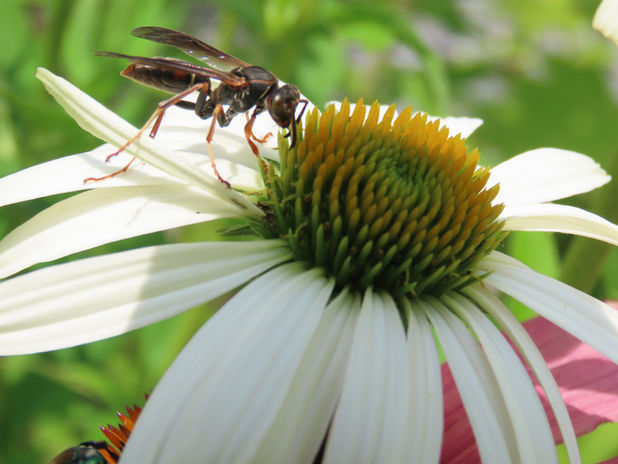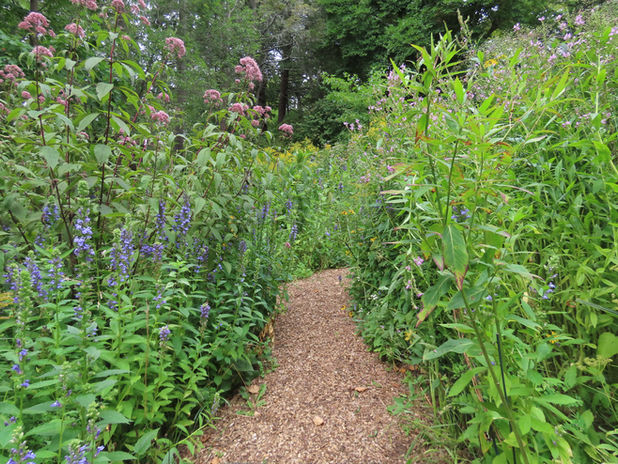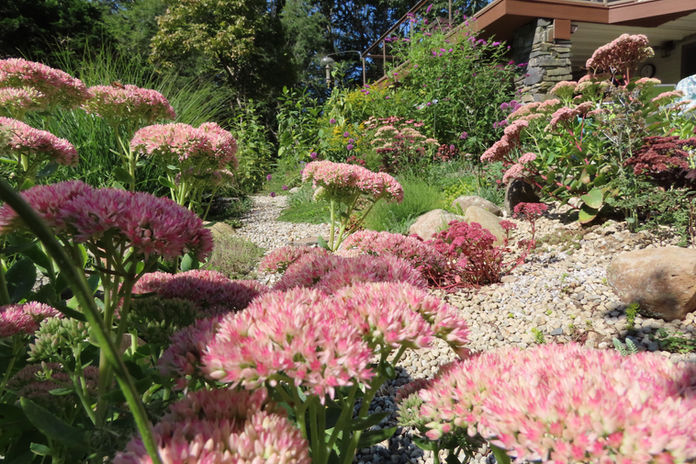Gardens for Bees, Butterflies and the Birds who eat them.
In this time of unstable climate, diminishing bugs, bees and birds it can feel like we are doomed. But I am here to tell you that the power of nature is yours to nurture and enjoy. Bringing Native plants into your garden changes the future! Why? Our native plants have a relationship with native bugs. Some summer afternoon, go out to your local land preserve or meadow. Walk, observe and listen to the buzzing of bees and sweet songbirds. Notice the only water comes in the form of rain and runoff. When you plant a native garden after 3 years you will rarely have to water. Now that is changing your future and all those new little lives that would not be there, if you had not made a home for them.🐝🐝🐝🐝🐝🐝
Rewild (ree-wahyld): Restore (an area of land) to its natural uncultivated state.
Planting native plants and grasses is the path of least resistance while gardening and the easiest way to attract more pollinators to your garden. When we plant these easy growers we are setting up a perfect storm for the bugs, birds and many species of bees to find shelter, lay eggs and eat other insects.This is key, each year the garden becomes a richer and mature habitat. A few things you may want know about wild gardens. Many of our Bees, Butterflies and other insects have a relationship with these native plants. The plant communities grow as the garden matures and life becomes richer, year by year. The magic is yours to observe. Making a difference starts by thinking of the life you can foster outside in your garden. Mow paths, if you must, tidy up a bit, but leave the leaves and create habitats with rocks, fallen trees, bark mulch and a few water sources, magic will happen, I promise.






Why Asters ???
Asters are late season nectar for our migrating butterflies and food for our native bees and other insects.
So many native varieties to choose from! Your local nursery usually starts bringing them out in the summertime. If you ask they may be able to get them to you sooner. Asters are terrific in the garden and create a show that lasts from late August to the last big frost! Months of color and plants decorated with butterflies, birds and bees with a plant that easily takes care of itself! We can change the future for our winged friends by providing the plants and flowers that give them the food they need. We also need to leave the stalks and stems until the spring, the birdies eat the seeds and some bugs lay their eggs in the hollow stems. When you clean up in the spring, cut up the stalks and leaves and use as mulch. We never want to get rid of leaves or stems, that is the next years bugs for the garden.
ASTER GROWING TIPS
Asters live in many different Habitats. From very wet, Bog Asters, to very dry, Flat topped Asters these flowering plants are adaptable to most climates. Native varieties exist the world over. A wonderful trait, they can grow almost anywhere their seed can take hold, even in a crack in the sidewalk, a rocky ledge and places that are hot and dry and can winter over in the far north! They do not need much fuss or care, they prefer to be left alone to do their job of providing food and habitat to the landscape. You can plant seeds or plants, plugs to larger sizes, and if you water the first year you will have success, some seeds take a few years to pop up and make a statement. You will be treated to all of the life these beauties and their companion plants attract to the garden. Here in Maine we have 200 varieties of Native Bees and scores of Butterflies and Moths. It can be a winged insect paradise, if you plant nectar laden flowers and host plants they will populate your world with wonder. Imagine enchantment right outside your door.
Favorite Companion Plants:
Many Asters are Purple, Lavender, Blue and White. These plants mix well with our Native Plants. In the spring and summer they add great structure in the back and mid garden beds.
The many varieties of Goldenrod are spectacular and tall with a very rich yellow color. They mix well in the back of the garden, so majestic and buzzing with bees. Some varieties are shorter but most are tall! Rudbeckias are another family of golden yellow flowers that are quite wonderful growing amidst the clouds of flowering Asters. These varieties bloom from mid summer until the frost! Black Eyed Susans, Irish Eyes, Goldstrum and Henry Eilers. All are perennial and heavy bloomers, with very small water needs and start blooming as the early summer blossoms are fading. Some other great companions in a late fall garden are Verbena Borenensis ~ Echinacea, Native Prairie Coneflower ~ Eupatorium, Joe Pye Weed ~ Sedum, Autumn Joy ~ Ornamental Grasses ie. Mexican Feather Grass, and Little Blue Stem.
History: Back in the 60s this Asters fell out of favor, a new plant showed
up, easily grown, shorter, brighter and newly popular, The Chrysanthemum!
The Mum originally came from East Asia and Europe, while still in the
Asteraceae family it does not provide the nectar and food that our native
Asters provide. Once here the nursery industry created many cultivars
(cultivated varieties) which look beautiful to us, but provide no food to our
winged wonders! A shame. Now you know, please plant Asters. You can
collect the seeds on the roadsides and meadows, after the big frost.
No bugs or ticks around, just seeds. Keep in a paper sack, sprinkle liberally
in your garden, on hillsides and those awful hellstrips that plague every
city. You can change the world, one Aster seed at a time.
View the Aster slideshow!


ReWILD is a word that I use, why?
Because that’s what we need to do as a society. We need to let the fireflies and all other insects, bugs and birds live in our gardens.
All summer long we mow our lawns with efficiency. We make sure nothing that is living or any part of the lawn that could be habitat for our insects, is left behind. We need to be more relaxed when it comes to mowing and our gardens.
Did you know that if you mowed once a month or less with your mower on a higher setting you would enable a lawn of Fireflies glowing and making firefly love on those sultry summer nights in June and July. They’re nocturnal, and during the day they spend most of their time on the ground. At night, they crawl to the tops of blades of grass and fly into tree branches to signal for mates. Long grass conceals the fireflies and allows them a better vantage point for signaling at night, and over-mowing your lawn will disturb your firefly population. These dear insects beetles actually, live near ponds, streams, marshes, rivers and lakes, but they don’t need a lot of water to get by. Vernal pools and small depressions that hold water during firefly mating season can all provide the habitat fireflies need. Most firefly species live at the margins where forest or field meet water.


















































